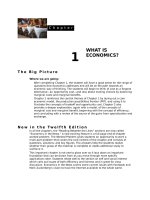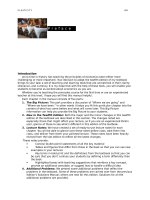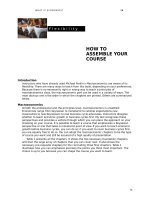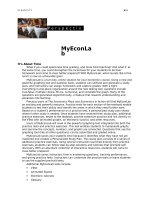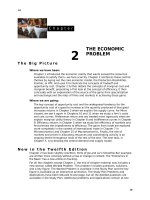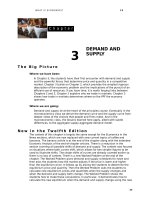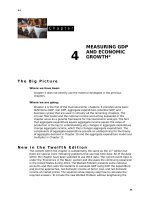Answers to review quizzes marcroeconomics 12e parkin chapter 14
Bạn đang xem bản rút gọn của tài liệu. Xem và tải ngay bản đầy đủ của tài liệu tại đây (369.75 KB, 20 trang )
W H AT I S E C O N O M I C S ?
225
C h a p t e r
Answers to the
Review Quizzes
1
4
MONETARY
POLICY**
Page 390 (page 798 in Economics)
1.
What are the objectives of monetary policy?
As set out in law, the objectives of monetary policy are to achieve “maximum
employment, stable prices, and moderate long-term interest rates.”
2.
Are the goals of monetary policy in harmony or in conflict (a) in the long run
and (b) in the short run?
The monetary policy goals are essentially in harmony for the long run. In the long
run, stable prices will bring about maximum employment because firms and
households can make the best possible decisions against a backdrop of stable
prices. With stable prices, the inflation rate is low—perhaps even zero if prices are
precisely stable. The nominal interest rate equals the real interest rate plus the
(expected) inflation rate. If the inflation rate is low, then the nominal interest rate
will be as low as possible. In the short run, however, the monetary policy goals
might conflict with each other. In the short run, in a recession the Federal Reserve
might lower the federal funds rate and increase the growth rate of the quantity of
money to combat the recession. The Fed’s policy will increase employment and
real GDP but also increase the price level and eventually the nominal interest rate.
3.
What is the core inflation rate and how does it differ from the overall CPI
inflation rate?
The core inflation rate is the rate of increase in the core PCE deflator. The core PCE
deflator is the personal consumption expenditure deflator excluding food and fuel
The Federal Reserve believes that food and fuel prices are more volatile than other
prices and largely respond to factors other than the state of inflation in the general
economy. Accordingly, the core inflation rate is smoother, that is, less volatile than
the actual inflation rate.
4.
Who is responsible for U.S. monetary policy?
The Governors of the Federal Reserve System and the Federal Open Market
Committee (FOMC) are responsible for the conduct of U.S. monetary policy.
Page 392 (page 800 in Economics)
1.
What is the Fed’s monetary policy instrument?
225
226
While the Fed could use the quantity of money, the exchange rate, or a short-term
interest rate, the Fed chooses to use a short-term interest rate, in particular, the
federal funds rate. The federal funds rate is the interest rate on overnight loans of
reserves that commercial banks make to each other.
2.
How is the federal funds rate determined in the market for reserves?
The federal funds rate is determined by equilibrium in the reserve markets. The
federal funds rate is the rate that sets the quantity of reserves demanded equal to
the quantity of reserves supplied.
226
3.
What are the main influences on the FOMC federal funds rate decision?
Though the Federal Reserve does not use an explicit formula to determine changes
in its targeted federal funds rate, the Fed seems to respond to the inflation rate,
the unemployment rate, and the output gap when determining its federal funds
target rate.
Page 401 (page 809 in Economics)
1.
Describe the channels by which monetary policy ripples through the economy
and explain how each channel operates.
When the Federal Reserve lowers the federal funds rate, other short-term interest
rates also fall. As a result, the exchange rate falls because investors decrease their
demand for U.S. dollars since the interest yield on dollars is lower. When the
Federal Reserve lowers the federal funds rate it does so by buying securities in the
open market. Bank reserves increase so that banks have excess reserves. Because
banks have excess reserves, they loan the excess. Loans increase and a multiple
expansion of the quantity of money results. The supply of loanable funds increases
so that the long-term real interest rate falls and consumption and investment
increase. Net exports increase because of the lower exchange rate. All three of
these changes increase aggregate demand, so that real GDP growth and the
inflation rate both increase.
2.
Do interest rates fluctuate in response to the Fed’s actions?
Yes, interest rates fluctuate in response to the Fed’s actions. Indeed, the first effect
of a change in monetary policy is a change in the federal funds interest rate.
3.
How do the Fed’s actions change the exchange rate?
A change in the U.S. interest rate changes the U.S. interest rate differential. For
example, a rise in the U.S. interest rate, other things remaining the same, means
that the U.S. interest rate differential increases. When the U.S. interest rate
differential increases people want to move funds from other countries into the
United States to obtain the relatively higher returns on U.S. assets. To move funds
into the United States, people buy dollars and sell other currencies, driving the
price of the dollar up. A higher dollar means that foreigners must pay more for
U.S.-made goods and services and Americans pay less for foreign goods and
services. So the rise in the interest rate means that exports decrease and imports
increase, corresponding to a fall in net exports.
4.
How do the Fed’s actions influence real GDP and how long does it take for
real GDP to respond to the Fed’s policy changes?
The Fed’s actions affect real GDP by changing expenditure plans. For instance, an
expansionary policy by the Fed that lowers the interest rate increases consumption
expenditure, investment, and net exports. All three of these changes boost
aggregate demand so that real GDP growth increases. The effect on real GDP is far
from immediate because there are time lags in the process. Real GDP initially
responds about two years after the policy is initiated.
5.
How do the Fed’s actions influence the inflation rate and how long does it
take for inflation to respond to the Fed’s policy changes?
The Fed’s actions affect the inflation rate and the price level by changing
expenditure plans. For instance, an expansionary policy by the Fed that lowers the
interest rate increases consumption expenditure, investment, and net exports. All
three of these changes boost aggregate demand so that the price level rises and
the inflation rate increases. The effect on the price level and inflation rate is far
from immediate because there are time lags in the process. The change in inflation
is slower than the change in real GDP.
M O N E TA RY P O L I C Y
Page 405 (page 813 in Economics)
1.
What are the three ingredients of a financial and banking crisis?
A financial and banking crisis occurs when there is a widespread fall in assets
prices, a significant currency drain, and a run on banks. When these events
occur, banks and other financial institutions face incipient failure and so they
drastically decrease their lending activities.
2.
What are the policy actions taken by the Fed and the U.S. Treasury in
response to the financial crisis?
The Fed and the U.S. Treasury have undertaken eight policies designed to combat
the financial crisis. The Fed conducted massive open market operations to provide
liquidity to banks. To provide liquidity to money market funds, the Fed also created
an asset-backed commercial paper money market mutual fund liquidity facility. To
provide liquidity to other financial institutions, the Fed allowed created programs
that allowed term auction credit and also primary dealer and other broker credit.
The U.S. Treasury engaged in two Troubled Asset relief Programs, TARP 1 and TARP
2. TARP 1 was designed to give banks more liquidity. Under it banks were to sell
troubled assets to the U.S. Treasury in exchange for U.S. government assets. This
program did not work well and was replaced by TARP 2. Under TARP 2 the U.S.
Treasury directly purchased stock in financial institutions, thereby increasing their
solvency and making their failure less likely. Finally, accounting rules were
changed to allow financial institutions to use fair value accounting rather than
mark-to-market accounting to value assets. This change also increased their
solvency and made failure less likely.
3.
Why was the recovery from the 2008–2009 recession so slow?
The recovery from the recession has been slow because investment has not
rebounded. Investment has remained low because of uncertainty about the future.
4.
How might inflation targeting improve the Fed’s monetary policy?
Inflation targeting, under which the Fed would make public its inflation target and
face penalties if the target was missed, would improve the Fed’s monetary policy
because it would remove uncertainty. The public would know what the Fed’s policy
was and would not need to guess at what the inflation rate would be the future.
This certainty would improve people’s decision making about saving and
investment and thereby improve economic performance.
5.
How might using the Taylor rule improve the Fed’s monetary policy?
The Taylor rules is a formula that sets the federal funds rate according to the
inflation rate and the output gap. This rule has worked well in computer
simulations when it comes to avoiding excessive inflation or recessions. Given this
track record, it might improve the Fed’s monetary policy and make the Fed better
able to avoid high inflation and recessions. It also has the advantage of inflation
targeting insofar as it removes uncertainty about what will be the Fed’s policy.
183
184
CHAPTER 14
Answers to the Study Plan Problems and
Applications
1.
“Unemployment is a more serious economic problem than inflation and it
should be the focus of the Fed’s monetary policy.” Evaluate this statement
and explain why the Fed’s primary policy goal is price stability.
The Fed’s primary goal is price stability because price stability helps the Fed reach
all three of its goals of maximum employment, stable prices, and moderate longterm interest rates. Price stability directly meets the second goal of price stability.
And because price stability means that the inflation rate is low, it helps keep
nominal long-term interest rates close to the long-term real interest rate. Finally
price stability helps consumers and businesses make better decisions about saving
and investment and thereby keep unemployment close to the natural rate.
2.
“Monetary policy is too important to be left to the Fed. The President should
be responsible for it.” How is responsibility for monetary policy allocated
among the Fed, the Congress, and the President?
The Fed has primary responsibility for the nation’s monetary policy. It is the FOMC
that decides upon monetary policy. The Congress plays, at best, a minor role. Each
year the Fed must make two reports to Congress about its monetary policy and the
Fed chairman testifies before Congress at these times. The President’s role is
limiting to appointing the members and the chairman of the Board of Governors,
though Presidents have tried to influence the Fed’s decisions.
3.
Fed’s Easing Has Little Impact So Far
The Federal Reserve’s latest easing program may be nicknamed “QE Infinity”
on Wall Street, but it’s having a limited effect on the economy so far.
Source: cnbc.com, October 3, 2012
a. What does the Federal Reserve Act of 2000 say about the Fed’s control of
the quantity of money?
The Federal Reserve Act of 2000 says that the Fed “shall maintain long-run growth
of the monetary and credit aggregates commensurate with the economy’s longrun potential to increase production, so as to promote effectively the goals of
maximum employment, stable prices, and moderate long-term interest rates.”
b. How can the massive increase in the monetary base resulting from
“quantitative easing” or QE be reconciled with the Federal Reserve Act of
2000?
The Fed is charged with setting monetary growth to “promote effectively the
goal(s) of maximum employment.” The massive increase in the monetary base
attempts to decrease the unemployment rate from its level at the time, near 9.5
percent, to something closer to the natural unemployment rate, thereby helping to
achieve its goal of maximum employment.
4.
What are the two possible monetary policy instruments, which one does the
Fed use, and how has its value behaved since 2000?
The Fed could use either the monetary base or the federal funds rate as its
monetary policy instrument. The Fed has chosen to use the federal funds rate.
Since 2000 the federal funds rate has been on a roller coaster. Starting from about
6.5 percent in early 2000, the federal funds rate fell for the next four years until it
reached 1 percent in the second quarter of 2004. From that time the federal funds
rate rose to slightly more that 5 percent in 2006 and 2007. After 2007 the federal
funds rate fell until it hit its historic low, 0.2 percent in 2008. From 2008 until 2015,
the federal funds rate has stayed at or below this historic low.
M O N E TA RY P O L I C Y
5.
How does the Fed hit its federal funds
rate target? Illustrate your answer with
an appropriate graph.
To hit its federal funds rate target, the Fed
uses open market operations to change
the quantity of reserves. Figure 14.1
illustrates this process. Initially the federal
funds rate target is 5.25 percent. The
quantity of reserves is $100 billion, as
indicated by RS0. If the Fed wants to lower
the federal funds rate to 2 percent, the
Fed will use open market purchases of
government securities to increase
reserves to $200 billion. These open
market operations will shift the supply of
reserves curve to RS1 and thereby lower
the equilibrium federal funds rate to the
targeted value, 2.00 percent.
6.
What does the Fed do to determine whether the federal funds rate should be
raised, lowered, or left unchanged?
The Fed changes in the federal funds rate based on its forecasts of the three
economic variables: the inflation rate, the unemployment rate, and the output
gap. If the inflation rate is forecasted to rise, the unemployment rate is forecasted
to fall, or the output gap is forecasted to fall and perhaps become an inflationary
gap, the Fed might be concerned about inflation and push the federal funds rate
up. If the inflation rate is forecasted to fall, the unemployment rate is forecasted to
rise, or the output gap is forecasted to rise, the Fed might be concerned about
unemployment and push the federal funds rate down.
Use the following news clip to work Problems 7 and 8.
Fed Sees Unemployment and Inflation Rising
It is May 2008 and the Fed is confronted with a rising unemployment rate and
rising inflation.
Source: CNN, May 21, 2008
7.
Explain the dilemma faced by the Fed in May 2008.
Rising unemployment calls for expansionary monetary policy, that is, a cut in the
interest rate to lower the unemployment rate. This policy, however, raises the
inflation rate. Rising inflation calls for a contractionary monetary policy, that is, a
hike in the interest rate to lower the inflation rate. This policy, however, raises the
unemployment rate. So if the Fed combats unemployment, it worsens the inflation
problem. But if the Fed combats inflation, it worsens the unemployment problem.
8. a. Why might the Fed decide to cut the interest rate in the months after May
2008?
The Fed might have decided to cut the interest rate after May 2008 if
unemployment worsened and became a more severe problem than inflation.
185
186
CHAPTER 14
b. Why might the Fed have decided to raise the interest rate in the months
after May 2008?
The Fed might have decided to raise the interest rate after May 2008 if inflation
worsened and became a more severe problem than unemployment.
M O N E TA RY P O L I C Y
Use the following data to work Problems 9 to
11.
The Bureau of Economic Analysis reported
that business investment in the second
quarter of 2012 was $1,483 billion, $97
billion less than in 2008.
9.
Explain the effects of the Fed’s low
interest rates on business investment
and use a graph to illustrate your
explanation.
The low interest rates are achieved by
increasing banks’ reserves, which leads
to an increase in the supply of loanable
funds. Then, as illustrated in Figure 14.2,
the increase in the supply of loanable
funds lowers the real interest rate, in the
figure from 5 percent per year to 3
percent per year. The fall in the real
interest rate increases firms’ purchase of investment items, such as factories,
plants, machine tools, and so forth, because it makes their purchase less
expensive.
10.
Explain the effects of business investment on aggregate demand. Would you
expect it to have a multiplier effect?
Why or why not?
The increase in investment increases
aggregate demand as illustrated in
Figure 14.3. It is likely that the increase
in investment has a multiplier effect.
The initial increase in investment
increases real GDP and consumers’
disposable income. In turn the increase
in disposable income induces additional
consumption expenditure, which serves
to further increase aggregate demand
and real GDP.
11.
What actions might the Fed take to
stimulate business investment further?
The Fed might commit to keeping the
inflation rate low by stating that it will
raise the interest rate at some specified
point in the future if inflation starts to
pick up. This commitment would help dispel fears of inflation. It would also make
clear that buying investment goods will be cheaper at the present time, when the
interest rate is low, then in the future, when the interest rate rises. This belief
would lead firms to increase their investment at the present time.
187
188
CHAPTER 14
Use the following news clip to work Problems 12 to 14.
IMF Warns Global Economic Slowdown Deepens, Prods U.S., Europe
The IMF said the global economic slowdown is worsening and warned U.S. and
European policymakers that failure to fix their economic ills would prolong the
slump.
Source: Reuters, October 9, 2012
12. If the IMF forecasts turn out to be correct, what would most likely happen to
the output gap and unemployment in 2013?
The “global economic slowdown” means that the output gap will probably increase
and the unemployment rate will either rise or not change.
13.a. What actions taken by the Fed in 2011 and 2012 would you expect to have
influenced real GDP growth in 2013? Explain how those policy actions would
transmit to real GDP.
The Fed has undertaken monetary stimulus of almost historic proportions. The Fed
has driven the federal funds rate to its lowest level ever, virtually 0 percent. The
Fed has engaged in bouts of quantitative easing. These expansionary policies are
designed to increase consumption
expenditure, net exports, and particularly
investment and thereby increase
aggregate demand. The Fed’s goal is to
increase aggregate demand and by so
doing increase real GDP and employment,
which would lower the stubbornly high
unemployment rate.
b. Draw a graph of aggregate demand
and aggregate supply to illustrate your
answer to part (a).
Figurer 14.4 shows the outcome described
in part (b). In the absence of the Fed’s
policy, the aggregate demand curve
would be AD0 and the aggregate supply
curve would be SAS. The Fed’s
expansionary policies increased
aggregate demand so the aggregate
demand curve shifts to AD1. In the
absence of the Fed’s policies, real GDP would be $12.7 trillion and the price level
would be 119. The Fed’s expansionary policies have raised the price level to 121
and increased real GDP to $12.9 trillion.
14.
What further actions might the Fed take in 2013 to influence the real GDP
growth rate in 2014? (Remember the time lags in the operation of monetary
policy.)
The time lags in the operation of monetary policy suggest that any further
expansionary policy the Fed takes in 2013 likely will have a small effect in 2014. If,
early in 2013 the Fed conducts a further quantitative easing, by buying a
significant quantity of assets, there might be a positive impact on real GDP and
employment in late 2014.
M O N E TA RY P O L I C Y
15.
Prospects Rise for Fed Easing Policy
William Dudley, president of the New York Fed, raised the prospect of the Fed
becoming more explicit about its inflation goal to “help anchor inflation
expectations at the desired rate.”
Source: ft.com, October 1, 2010
What monetary policy strategy is Mr. Dudley raising? How does inflation
targeting work and why might it “help anchor inflation expectations at the
desired rate”?
Mr. Dudley is suggesting that the Fed move toward inflation rate targeting.
If the Fed followed a policy of inflation rate targeting, it would make a public
commitment about its inflation rate target and would explain how its policy actions
will achieve its goal. Inflation rate targeting gives the public guidance about what
the central bank expects the inflation rate will be. This will help “anchor inflation
expectations” and, as long as the announced inflation rate target is the desired
rate, it will help anchor the expectations “at the desired rate.”
189
190
CHAPTER 14
Answers to Additional Problems and Applications
Use the following information to work Problems 16 to 18.
The Bank of Korea’s monetary policy is to reduce the vulnerability of South Korean
won and achieve price stabilization through increasing money supply and lowering
interest rates.
16. How does the Bank of Korea attempt to minimize the output gap through
money supply and interest rates?
To minimize the output gap (recessionary gap), as the Bank of Korea increases
money supply by buying securities in an open-market operation, the Bank of Korea
base rate falls. A lower interest rate boosts investment expenditure. As the
interest rates fall in comparison to other countries, say, the U.S., keeping other
factors unchanging, the South Korean won depreciates against the U.S. dollar,
which increases net exports. The combined effect is that aggregate demand
increases, implying a rightward shift in the aggregate demand curve. A multiplier
process begins too. The increase in aggregate demand increases income, which in
turn induces an increase in consumption expenditure. Aggregate demand further
shifts to the right and the new equilibrium GDP will be higher. Money supply keeps
increasing until the equilibrium GDP reaches the potential GDP.
17.
How does the policy affect the price level in the short run and the long run?
Given the short-run aggregate supply, when aggregate demand keeps increasing
due to continuous increase in money supply, the price level continues to increase
until the potential GDP is reached. At full-employment equilibrium, the price level
remains stable.
18.
Can the Bank of Korea achieve price stability and economic growth
simultaneously?
The Bank of Korea cannot have both price stability and economic growth
simultaneously in the short term. Lowering inflation rate to achieve price stability
might entail increasing interest rate which would lower employment and real GDP,
thereby discouraging economic growth. The central bank has to prioritize. In the
years of 2014 and 2015, the Bank of Korea has been found inclined to have
economic growth as its first priority while accepting a small increase in price in the
short run.
19.
What is the core inflation rate and why does the Fed regard it as a better
measure on which to focus than the CPI?
The core inflation rate is the rate of increase in the core personal consumption
expenditure (PCE) deflator. The core PCE deflator is the personal consumption
expenditure deflator excluding food and fuel. The Federal Reserve believes that
food and fuel prices are more volatile than other prices and largely respond to
factors other than the state of inflation in the general economy. Accordingly, the
core inflation rate is the inflation rate over which the Fed believes it has the
greatest control.
20.
Suppose Congress decided to strip the Fed of its monetary policy
independence and legislate interest rate changes. How would you expect the
policy choices to change? Which arrangement would most likely provide price
stability?
If interest rates are determined by Congress, there would be a bias toward
persistently increasing monetary growth to keep the interest rate low and help the
re-election prospects of legislators. While this policy is successful in the short run,
in the long run the higher monetary growth leads to higher inflation. In turn, the
M O N E TA RY P O L I C Y
higher inflation rate leads to a higher nominal interest rate. Keeping the Fed
independent of Congress is most likely to provide price stability.
Use the following CBO report to work Problems 21 to 23.
Fiscal 2012 Deficit: Smaller, But Still Big
The budget deficit was about $1.1 trillion in fiscal year 2012, CBO estimates. That
is about $200 billion smaller than in 2011, but still ranks as the fourth-largest
deficit since World War II.
Source: Congressional Budget Office
21. How does the federal government get funds to cover its budget deficit? How
does financing the budget deficit affect the Fed’s monetary policy?
The federal government borrows the funds. Borrowing, by selling government
securities, is how the federal government funds its budget deficit. When the
government borrows to fund its deficit, the increased demand for loanable funds
raises the real interest rate.
The budget deficit has no direct impact on the Federal Reserve’s monetary policy.
But the budget deficit might exert an indirect effect. For its monetary policy, the
Federal Reserve targets the federal funds rate and uses open market operations to
meet the target. When government borrowing raises the real interest rate, the
federal funds rate rises. The rise in the federal funds rate might affect the Fed’s
assessment of the level at which to target the federal funds rate.
22.
How was the budget deficit of 2012 influenced by the Fed’s low interest rate
policy?
The Fed’s low interest rate policy lowered the interest payments the federal
government had to make on its debt. Therefore the low interest rate policy
decreased the amount of government spending and hence decreased the size of
the government budget deficit.
23.a. How would the budget deficit change in 2013 and 2014 if the Fed moved
interest rates up?
If the Fed boosts interest rates, the government payments on its debt will increase.
The higher payments increase the amount of government spending and therefore
increase the size of the budget deficit.
b. How would the budget deficit change in 2013 and 2014 if the Fed’s
monetary policy led to a rapid depreciation of the dollar?
A rapid depreciation of the dollar can have two effects on the budget deficit. First it
can increase the U.S. inflation rate. With the increase in the inflation rate, inflation
expectations would increase, thereby increasing interest rates. The increase in the
interest rate increases the budget deficit because the government must increase
the interest payments it makes on its debt. Second, a rapid depreciation of the
dollar can also increase U.S. net exports which decreases the U.S. unemployment
rate. A decrease in unemployment decreases the needs-based expenditure the
government must make and thereby lowers the budget deficit.
24.
The Federal Reserve Act of 2000 instructs the Fed to pursue its goals by
“maintain[ing] long-run growth of the monetary and credit aggregates
commensurate with the economy’s long-run potential to increase production.”
a. Has the Fed followed this instruction?
The Fed would argue that it has tried to follow this instruction. The Fed would point
to the relatively low inflation rate as evidence that it did not let the growth rate of
191
192
CHAPTER 14
the quantity of money get out of hand. And the Fed would argue that the financial
crisis and ensuing recession is not the fault of its monetary policy.
b. Why might the Fed increase money by more than the potential to increase
production?
During a recession the Fed increases the quantity of money by more than the
“long-run potential” in an effort to conduct a monetary policy that moves real GDP
back to its “long-run potential.”
25.
Looking at the federal funds rate since 2000, identify periods during which,
with the benefit of hindsight, the rate might have been kept too low. Identify
periods during which it might have been too high.
Some analysts assert that the federal funds rate was too low during the period
from 2001 to 2005. During this period house prices skyrocketed. It was the
following rapid fall in house prices, starting in 2006, that helped lead to the
financial crisis. These analysts say that if the Fed had raised interest rates earlier,
then demand for housing would have not been as strong, thereby limiting the rise
in house prices.
Some observers believe that the Fed kept interest rates too high at the start of in
2000 and in 2006-2007. In both periods the economy was poised to enter a
recession. These observers say that if the Fed had lowered the interest rate before
the economy entered the recession, the following recession would have been
milder and might have been avoided all together.
M O N E TA RY P O L I C Y
26.
Now that the Fed has created $3 trillion of bank reserves, how would you
expect a further open market purchase
of securities to influence the federal
funds rate? Why? Illustrate your answer
with an appropriate graph.
The Fed’s immense creation of $3 trillion
of bank reserves might mean that further
open market operations would have no
effect on the federal funds rate. The $3
trillion of reserves has sent the federal
funds to virtually 0 percent, so there is
little room for it to fall further. At this
exceedingly low federal funds rate, banks
might be willing to hold any quantity of
additional reserves. In this situation, as
Figure 14.5 illustrates, the demand curve
for reserves is horizontal. If the demand
curve for reserves is flat, then increasing
the quantity of reserves has no effect on
the federal funds rate because banks
merely hold the additional reserves. Banks hold the reserves because the
opportunity cost of holding them rather than loaning them in the federal funds
market is so low.
27.
What is the Beige Book and what role does it play in the Fed’s monetary
policy decision-making process?
The Beige Book is a key element in the Fed’s monetary policy decision-making
process. The Beige Book summarizes economic conditions within each of the
Federal Reserve districts. It provides the FOMC important information about the
current state of the economy that, together with forecasts of the future evolution of
the economy, determines the nation’s monetary policy.
To work Problems 28 to 30, use the information that during 2012 the inflation rate
increased but remained in the “comfort zone” and the unemployment rate
remained high.
28.
Explain the dilemma that rising inflation and high unemployment poses for
the Fed.
Raising inflation and high unemployment pose a dilemma for the Fed because the
policy necessary to decrease one of these factors increases the other. On one
hand, to control inflation, the Fed must raise the interest rate and decrease growth
in the quantity of money. But this policy raises the unemployment rate. However,
on the other hand to control high unemployment the Fed needs to lower the
interest rate and increase the growth rate of the quantity of money. But this
expansionary policy raises the inflation rate.
29.
Why might the Fed decide to try to lower interest rates (or stimulate in other
ways) in this situation?
The Fed might lower the interest rate because it perceives high unemployment as
a larger problem than inflation because inflation, while increasing, was in the
“comfort zone.”
193
194
30.
CHAPTER 14
Why might the Fed decide to raise interest rates in this situation?
The Fed might raise the interest rate if it perceives that inflation will rise outside of
its comfort zone and if it perceives the rising inflation as a larger problem than the
high unemployment.
M O N E TA RY P O L I C Y
Use the following information to work Problems 31 to 33.
From 2009 through 2012, the long-term real interest rate paid by the safest U.S.
corporations fell from 4 percent to 2 percent. During that same period, the federal
funds rate was roughly constant at 0.25 percent a year.
31. What role does the long-term real interest rate play in the monetary policy
transmission process?
The long-term real interest rate plays an important part in the monetary
transmission process. Both consumption expenditure and investment respond to
the long-term real interest rate. When the long-term real interest rate falls,
consumption expenditure and investment both increase. The increase in
consumption expenditure and investment increase aggregate demand and thereby
increase real GDP and the price level.
32.
How does the federal funds rate influence the long-term real interest rate?
The long-term interest rate is an expected average of short-term interest rates.
People can either borrow or save by making a long-term commitment or by
making successive short-term commitments. Adjusted for risk, the average of the
interest rates on the short-term commitments must equal the long-term interest
rate. If they were not equal one method of borrowing would be more or less
expensive than the other. People would stream to borrow using the less expensive
method, pushing that interest rate higher, back toward equality. Simultaneously
other people would stream to save using the method with the higher return,
pushing that interest rate lower, back toward equality. When the Fed lowers the
federal funds rate, other short-term interest rates also fall. This fall makes
borrowing by using a series of short-term loans less expensive and saving using a
series of short-term commitments less profitable. The demand for long-term loans
falls, which lowers the long-term interest rate and the supply of long-term saving
commitments rises, which also lowers the long-term interest rate. So a fall in the
federal funds rate lowers the long-term real interest rate.
33.
What do you think happened to inflation expectations between 2009 and
2012 and why?
Inflation expectations probably increased. The expected inflation rate equals the
nominal interest rate minus the real interest rate. Over this time period, the federal
funds rate did not change, so the nominal interest rate did not change. But the real
interest rate fell. Therefore inflation expectations increased.
34.
Dollar Reaches New Low vs. Yen
Traders continued to make bets in favor of the yen, sending the dollar to a
record low against the Japanese currency.
Source: The Wall Street Journal, August 20, 2011
a. How do “bets in favor of the yen” influence the exchange rate?
“Bets in favor of the yen” are “bets” that the yen will rise in the future. To place
this “bet,” traders need to buy yen. The demand for yen increases, which raises
the value of the yen and lowers the dollar exchange rate.
b. How does the Fed’s monetary policy influence the exchange rate?
The Fed’s monetary policy affects U.S. interest rates, which affect the exchange
rate. For example, if people expect the Fed to either lower U.S. interest rates or else
keep U.S. interest rates lower for a longer period of time, the fall in expected
interest rates lowers the exchange rate. U.S. savers become more likely to sell
dollars to acquire foreign exchange to save abroad, so the supply of dollars
increases. Foreign savers become less likely to buy dollars to save in the United
States, so the demand for dollars decreases. On both counts the U.S. exchange
rate falls.
195
196
CHAPTER 14
Use the following news clip to work Problems 35 and 36.
As US Growth Lags, Some Press the Fed to Do Still More
The Fed’s campaign to increase growth is not working. Economists blame the
prudent, slow-acting monetary policy of the Fed, especially with regard to the pace
of inflation, for the growth lags.
Source: The New York Times, Feb 1, 2013
35. The short-term interest rates have been held near zero since December 2008.
The Fed is being urged to push inflation to accelerate growth. How does the
monetary policy of managing inflation expectations help?
Long-term real interest rate equals long-term nominal interest rate minus expected
inflation rate. Given the nominal interest rate is near zero, if the Fed pushes
inflation, inflation expectations will rise, the real interest rate will fall. Other things
remaining the same, the lower the real interest rate, the greater the investment
and consumption expenditure. Aggregate demand increases, which increases real
GDP.
36.
Describe how the slow response of the real economy to the monetary policy
of the Fed can explain the growth lag.
The lags between the Fed’s actions and their effect on the real economy are
substantial It takes time before the policy affects output. Even if the interest rate
drops, firms are unlikely to change their investment plans immediately. Consumers
may not increase their consumption, if they are not sure that their incomes are
going to increase in the long run. In addition, lower interest rates lead to a
depreciation of home currency, but exports may not increase and imports may not
decrease immediately as the amount of exports and import are bound by
contracts, schedules and production plans for a period of time.
37.
Philly Fed’s Plosser Opposes QE3
Federal Reserve Bank of Philadelphia president Charles Plosser does not think
that monetary policy can “do much to speed up the slow progress” in the
labor market and opposes the Fed’s latest round of stimulus, known as QE3,
saying he does not think it prudent to risk the Fed’s hard-won credibility.
Source: Philadelphia Inquirer, September 25, 2012
a. Describe the QE3 asset purchases that are causing Charles Plosser concern.
Mr. Plosser is concerned about the Fed’s large purchases of mortgage-backed
securities.
b. How might asset purchases damage the Fed’s credibility?
The asset purchases might cause people to doubt the Fed’s commitment to price
level stability. The asset purchases increase banks’ reserves and if banks loan
these reserves, the money supply could expand significantly and with it the price
level and inflation rate might jump higher.
38.
Suppose that the Reserve Bank of New Zealand is following the Taylor rule. In
2012, it sets the official cash rate (its equivalent of the federal funds rate) at
4 percent a year. If the inflation rate in New Zealand is 2 percent a year, what
is its output gap?
The Taylor rule sets the official cash rate according to CASH = 2 + INF + 0.5(INF −
2) + 0.5GAP. So the with a cash rate of 4 percent and an inflation rate of 2 percent,
the Taylor rule is that 4 = 2+ 2 + 0.5(2 – 2) + 0.5GAP, or 4 = 4 + 0.5GAP. The last
equation shows that the output gap is 0 percent.
M O N E TA RY P O L I C Y
Use the following news clip to work Problems 39 and 40.
Bernanke on Inflation Targeting
Inflation targeting promotes well-anchored inflation expectations, which facilitate
more effective stabilization of output and employment. Thus inflation targeting can
deliver good results with respect to output and employment as well as inflation.
Source: Federal Reserve Board, remarks by Ben Bernanke
to the National Association of Business Economists, March
25, 2003
39.
What is inflation targeting and how do “well anchored inflation expectations”
help to achieve more stable output as well as low inflation?
Inflation targeting is a monetary policy strategy in which the central bank makes a
public commitment to achieve a specific inflation rate goal. Inflation rate targeting
helps “anchor expectations” because the public has a good idea of hat the
inflation rate will be. There are fewer gyrations in inflation expectations which lead
to fewer changes in the real interest rate and, accordingly fewer changes in
investment and consumption expenditure. Because aggregate demand is more
stable, so, too, is output.
40.
Explain how inflation targeting as described by Ben Bernanke is consistent
with the Fed’s dual mandate.
The Fed’s dual mandate is to maintain stable prices and maximum employment.
By setting a low inflation rate target, the Fed directly helps achieve its goal of
stable prices , which is the best environment for households and firms to make the
saving and investment decisions. By limiting fluctuations in aggregate demand,
the Fed can keep real GDP growing at a rate that more closely approximates its
long-term trend.
Economics in the News
41.
After you have studied Economics in the News on pp. 406–407 (814–815 in
Economics) answer the following questions.
a. What was the state of the U.S. economy in the fall of 2014 when the Fed
made the decision to commit to keeping interest rates low for a
“considerable time”?
The economy was mired in a very slow recovery from a very deep recession. The
unemployment rate was high by historical standards and a recessionary gap
existed. The Fed was concerned by the slow recovery from the recession.
b. What was the FOMC majority expectation about future employment, real
GDP, and inflation in September 2014?
The majority view was that the economy still had a large recessionary gap. The
majority expected that fed policy would lead to further increases in employment
and real GDP while the inflation rate would remain low.
c. How would an earlier and faster rise in interest rates influence aggregate
demand?
An earlier and faster rise in interest rates would lead to an earlier and stronger
restraint on the growth of consumption expenditure and investment and, thereby,
an earlier and stronger restraint on the growth of aggregate demand.
d. If the San Francisco Fed view of the output gap is correct, where will interest
rates be in 2016 and 2017? Why?
If the San Francisco Fed view of the output gap is correct, the Fed’s policy will lead
to an inflationary gap. Real GDP will exceed potential GDP and the inflation rate
197
198
CHAPTER 14
will start to rise. The rise in the inflation rate will raise interest rates. And the Fed’s
policy of raising the interest rate to lower the inflation rate will lead to a further
rise in interest rates.
M O N E TA RY P O L I C Y
42.
Fed’s Evans: Offers Full Support for New Stimulus
Federal Reserve Bank of Chicago President Charles Evans expressed strong
support for the new stimulus provided by the central bank saying, “This was
the time to act” and adding, “I am optimistic that we can achieve better
outcomes through more monetary policy accommodation.”
Source: The Wall Street Journal, September 18, 2012
a. Why, in the economic conditions of September 2012, was Charles Evans
happy to see the Fed stimulating the economy?
Mr. Evans was concerned that the economy still had a large recessionary gap and
that the economy might even move into another recession.
b. What would be the effects of the Fed’s QE3 and other stimulative actions?
Explain the immediate effects and the ripple effects.
If the Fed buys securities, banks’ reserves increase. The federal funds rate falls
and along with it other short-term interest rates fall. The exchange rate also falls.
The supply of money and the supply of loanable funds increase. The increase in
the supply of loanable funds lowers the real interest rate. Consumption
expenditure, investment, and net exports increase, which increases aggregate
demand. Real GDP increases and the price level rises.
c. What are the risks arising from greater monetary stimulus?
The risk from greater monetary stimulus is significantly higher inflation. If the
monetary stimulus is too great, it could propel the United States into a situation in
which inflation and inflation expectations soar.
199


